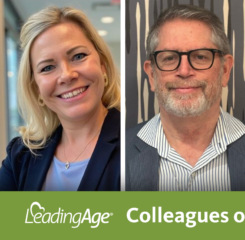LeadingAge NORC Poll: Older Baby Boomers’ Preferences on Aging
Contact: Lisa Sanders
lsanders@leadingage.org
202-508-9407 or 347-385-2218
Washington D.C. March 18, 2019 — How do older baby boomers want to age? Would they prefer to travel or work, to practice their religion, or engage in social activities? If these adults, ages 60-72, develop physical or cognitive impairments, would they prefer to live at home, with family or friends, or in a place that is professionally staffed to provide health care and help with daily activities? And what about living alone?
In a quest to better understand older adults’ attitudes and expectations around quality of life and aging — particularly should they become physically or cognitively impaired and need long term services and supports — LeadingAge, the association of nonprofit providers of aging services, in conjunction with NORC, in January 2019 surveyed a representative sample of 1200 older adults between the ages of 60 and 72. Selected because they are more likely to have peers who may already be experiencing the need for help with activities of daily living and can more easily imagine themselves in that position, we asked older boomers to imagine they had a physical or cognitive impairment and needed help.
Results from this study, noteworthy because of its focus on this particular age cohort (often called the “young old”), present new information that challenges many commonly held views about how older baby boomers want to age. In addition, our findings reveal preferences within the respondent group in key areas, such as where they want to live (their own home vs. a place with professional caregivers) and who should care for them (family vs. a professional, paid caregiver), based on age as well as on income.
“In just over one decade — 11 years from now — one in 5 Americans will be over the age of 65. Those who live to 65 have a 50:50 chance of needing some paid long term services and supports,” says Katie Smith Sloan, president and CEO of LeadingAge. “Policy makers, politicians, government and business leaders, as well as the general American population, need to be aware of the potential impact of the demographic changes currently under way in the U.S.”
Unveiling the results March 18 at the LeadingAge Leadership Summit in Washington D.C., LeadingAge experts Ruth Katz, SVP, Public Policy/Advocacy, and LeadingAge LTSS Center @UMass Boston Co-Directors Robyn Stone and Marc Cohen, as well as Majd Alwan, Executive Director, LeadingAge Center for Aging Services Technologies, provide analysis of the survey results’ implications for key areas including the aging services workforce, on policy impacting the delivery and financing of health care for older adults and on access to aging-services technology.
“These older baby boomers are expecting a full continuum of services, including home care, other community-based supports, affordable housing with services, assisted living, and nursing homes,” adds Ms. Smith Sloan. “Boomers have had alot of choices all their lives. As the population ages, it is our responsibility to keep providing the highest quality, most person-centered options and to continue finding new ways to serve those who need long-term services and supports.”
Key findings, below, and in this PDF:
- When help with daily activities is needed, people care most about safety, followed by being around family and having access to the outdoors.
- People understand that there are circumstances where “aging in place” may not be right for them.
- 40% said they would want to live somewhere other than their current home or apartment if they had a physical disability that required them to need help with daily activities. Most earlier studies and surveys report that the majority (76% or more) of adults say they want to stay in their own home. These earlier studies do not target older baby boomers and they do not ask for separate responses depending on whether the impairment is physical or cognitive.
- 14% said they’d move to a place that is staffed to provide health care plus help with daily activities if they needed help because of a physical disability. When asked where they would want to live if they needed help due to dementia, that number grew to 42%.
- Even with physical disability and a need for help with daily activities, 60% of respondents said they would prefer remaining itn their current home or apartment. That percentage dropped to 29% if they had dementia and a need for help with daily activities — far lower than has been reported in other surveys of all adults.
- There is a strong and persistent desire across age and income groups to avoid being a care burden to family. On the other hand, only 11 percent said that their biggest worry was going to a nursing home.
- When asked what worries them most if they were to need LTSS, the biggest worry by far was becoming a burden on family members. It was interesting to see that only 10% of respondents worried about not being able to stay in their community and only 11% worried about having to live in a nursing home.
- We asked about how concerned they would be about becoming socially isolated or feeling lonely if they needed help with basic living activities. People with higher incomes are less concerned than lower income individuals about becoming socially isolated and lonely and older people are less concerned than younger people.
- One out of three 70 years old and older baby boomers would prefer hiring someone if they became disabled, while only one in four of the 60 to 79 year olds would prefer to purchase care.
- Affordability was viewed as the biggest challenge to purchasing care among all respondents, including 55% of the wealthiest baby boomers. But the younger baby boomers have significantly lower incomes and report fewer retirement resources. This is really a concern for the boomers with incomes less than $30,000 because fewer of them are married, have family to live with, and have resources to purchase care should they become disabled
About the LeadingAge AmeriSpeaks Survey
The LeadingAge-NORC nationally representative poll of 1200 adults age 60 to 72 was conducted online and by telephone in both English and Spanish in January 2019 using a sample drawn from NORC’s probability-based AmeriSpeak Panel, which is designed to be representative of the U.S. population. The survey was developed by researchers at LeadingAge and the LeadingAge LTSS Center @UMass Boston.
About LeadingAge
The mission of LeadingAge is to be the trusted voice of aging. Our 6,000+ members and partners include nonprofit organizations representing the entire field of aging services, 38 state associations, hundreds of businesses, consumer groups, foundations and research centers. LeadingAge is also part of the Global Ageing Network, whose membership spans 50 countries. LeadingAge is a 501(c)(3) tax-exempt charitable organization focused on education, advocacy and applied research.

Most Recommended
October 15, 2025
 Shutdown Week Three: Impact of Ongoing Closure on Affordable Housing
Shutdown Week Three: Impact of Ongoing Closure on Affordable Housing
December 10, 2025
Fiscal Year (FY) Funding 2026
October 07, 2025
Immigrant Workforce Matching Program Brings Workforce Relief
Recently Added
December 18, 2025
HUD Delays HOTMA to 2027 for Multifamily Housing
December 17, 2025
 Colleagues on the Move, December 17, 2025
Colleagues on the Move, December 17, 2025
December 16, 2025



